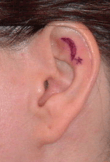Earlobe
| Earlobe | |
|---|---|
 | |
| Details | |
| System | Auditory system |
| Identifiers | |
| Latin | lobulus auriculae (singular), lobuli auricularum (plural) |
| Dorlands /Elsevier | l_13/12500813 |
| TA | A15.3.01.003 |
| FMA | 60984 |
The human earlobe is composed of tough areolar and adipose connective tissues, lacking the firmness and elasticity of the rest of the auricle (the external structure of the ear). In some cases the lower lobe is connected to the side of the face. Since the earlobe does not contain cartilage[1] it has a large blood supply and may help to warm the ears and maintain balance. The zoologist Desmond Morris in his book The Naked Ape (1967) conjectured that the lobes developed as an additional erogenous zone to facilitate the extended sexuality necessary in the evolution of human monogamous pair bonding.[2] However, earlobes are not generally considered to have any major biological function.[3] The earlobe contains many nerve endings, and for some people is an erogenous zone.


Structure
Inheritance
Earlobes average about 2 centimeters long, and elongate slightly with age.[4] Although the "free" vs. "attached" appearance of earlobes is often presented as an example of a simple "one gene - two alleles" Mendelian trait in humans, earlobes do not all fall neatly into either category; there is a continuous range from one extreme to the other, suggesting the influence of several genes.[5][6][7]
Distribution of recessive phenotype (attached ear lobe)
 = relative frequency of recessive alleles;
= relative frequency of recessive alleles;
 =
=  –
–  ;
;
 = relative frequency of dominant alleles.
= relative frequency of dominant alleles.

Clint Eastwood
| Population |  |
 |
| Africans | ? | 0,60 |
| Afroamericans | 242 | 0.56 |
| Bengal | 183 | 0,50 |
| Bosnia and Herzegovina[8] | 7.325 | 0,55 |
| Brooklyn – USA | 258 | 0,92 |
| Canadian Indians | 532 | 0,68 |
| Japan | 70 | 0,82 |
| Nepal | 169 | 0,66 |
| Pennsylvania – USA | 241 | 0,50 |
| Sardinia | 403 | 0,53 |
| Scotland | 500 | 0,48 |
| Sweden | 247 | 0,59 |
Clinical significance
Earlobes are normally smooth, but occasionally exhibit creases. Creased earlobes are sometimes associated with genetic disorders in children, including Beckwith-Wiedemann syndrome.[9] In some early studies, earlobe creases were thought to be associated with an increased risk of heart attack and coronary heart disease; however, more recent studies have concluded that since earlobes become more creased with age, and older people are more likely to experience heart disease than younger people, age may account for the findings linking heart attack to earlobe creases.[9] The earlobe crease is also called Frank's Sign.
Society and culture
.jpg)
Earlobe piercing and stretching
Piercing the earlobes is a commonplace activity in many cultures in many historical eras; no other location on the body is as commonly pierced. Consequently, injury to the earlobe due to the weight of heavy earrings is also common.[10] Some cultures practice earlobe stretching, using piercing ornaments to stretch and enlarge the earlobes to accommodate plugs.
Negative effects of wearing earrings
Some research has found that the most frequent complications connected with wearing earrings are:[11]
- Inflammation,
- Keloids,
- loss of tissue by tearing, and
- mechanical division of earlobes.
There was noticeable relationship between the piercing of young girls' earlobes and following development of allergy.[12][13][14] In the view of Professor Ewa Czarnobilska, the manager of the research team, the primary reason for the allergies connected to earrings is the presence of nickel, which is a common component of the alloys used in jewelry production.[13][14] The symptom seen is generally eczema, and is often misdiagnosed as a food allergy, for instance to milk. The specific mechanism in allergies caused by earrings is the contact of nickel ions with the Lymphatic system.[13][14]
The study noted that children who simply stopped wearing earrings did not see the disappearance of the allergic symptoms. The immune system remembers the presence of the nickel ions in the person's blood and lymph, so the child can still react to:[13][14]
- metal parts of wardrobe,
- Dental braces,
- Dental prosthesis,
- Orthotics,
- meals cooked in pots with addition of nickel,
- margarine (nickel is a catalyst in hydrogenation of unsaturated fats),
- coins,
- chocolate,
- nuts,
- leguminous vegetables,
- wine, and
- beer.
Research by allergists has found that in a sample of 428 pupils of ages 7–8 and 16–17 years old:[13][14]
- 30% of the research population showed an allergy to nickel, and
- the allergy occurred in girls who had started wearing earrings in early childhood.
Other symptoms of allergy to nickel are recurring infections, Asthma attacks and chronic larynxis.[13][13][14]
References
- ↑ Steinberg, Avraham (2003). Encyclopedia of Jewish Medical Ethics: a Compilation of Jewish Medical Law on All Topics of Medical Interest. Jerusalem: Feldheim Publishers. p. 350. ISBN 1583305920.
- ↑ Desmond Morris The Naked Ape: A Zoologist's Study of the Human Animal (Hardback: ISBN 0-07-043174-4; Reprint: ISBN 0-385-33430-3) Jonathan Cape, 1967 . Chapter 2, page 59 of Corgi paperback ed
- ↑ Popelka (31 August 1999). "Re:Why do we have earlobes, what are they for, since when?". MadSci Network. Retrieved 16 July 2015.
- ↑ Azaria R, Adler N, Silfen R, Regev D, Hauben DJ (June 2003). "Morphometry of the adult human earlobe: a study of 547 subjects and clinical application". Plast. Reconstr. Surg. 111 (7): 2398–402; discussion 2403–4. doi:10.1097/01.PRS.0000060995.99380.DE. PMID 12794488.
- ↑ Boaz N. T. (1999): Essentials of biological anthropology. Prentice Hall, New Jersey,ISBN 0-13-080793-1.
- ↑ Mader S. S. (2000): Human Biology. McGraw–Hill, New York, ISBN 0-07-290584-0.
- ↑ Dutta P., Ganguly P. (1965): Further observations on ear lobe attachment. Acta Genet. Statist. Med. 15: 77-86, 1965. [PubMed: 14277139, related citations]
- ↑ Hadžiselimović R. (1981): Genetic distance among local human populations in Bosnia and Herzegovina (Yugoslavia). Coll. Antrop., 5. (Suppl.): 63-66.
- 1 2 MedlinePlus Encyclopedia Earlobe creases
- ↑ HELGAADMIN (15 December 2014). "Are your Earlobes Attached?". Quantum Healing Institute Blog.
- ↑ Watson, D (2002). "Torn earlobe repair". Otolaryngologic Clinics of North America 35 (1): 187–205, vii–viii. doi:10.1016/s0030-6665(03)00102-6. PMID 11781215.
- ↑ Harmful earrings (pl. Szkodliwe kolczyki) Fizjointormator. Retrieved 2015-04-01
- 1 2 3 4 5 6 7 Polish Scientists wearn: earrings harm children (pl. Polscy naukowcy ostrzegają: kolczyki szkodzą dzieciom) Tvn24 Retrieved 2015-04-01
- 1 2 3 4 5 6 Czarnobilska E., Oblutowicz K., Dyga W., Wsołek-Wnek K., Śpiewak R. (May 2009). "Contact hypersensitivity and allergic contact dermatitis among school children and teenagers with eczema.". Contact Dermatitis (John Wiley & Sons A/S) 60 (5): 264–269. doi:10.1111/j.1600-0536.2009.01537.x.
| ||||||||||||||||||||||||||||||||||||||||||||||||||